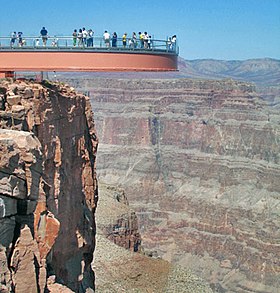
The Grand Canyon is a steep-sided canyon carved by the Colorado River in Arizona, United States. The Grand Canyon is 277 miles (446 km) long, up to 18 miles (29 km) wide and attains a depth of over a mile.

Supai is a census-designated place (CDP) in Coconino County, Arizona, United States, within the Grand Canyon.

Peach Springs is a census-designated place (CDP) in Mohave County, Arizona, United States. The population was 1,098 at the 2020 census. Peach Springs serves as the administrative headquarters of the Hualapai people and is located on the Hualapai Reservation.
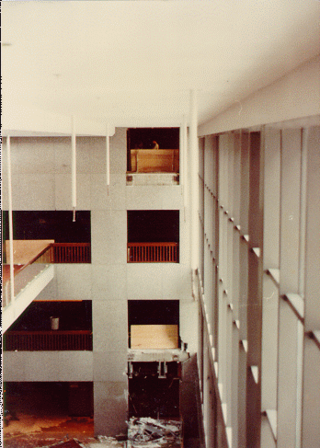
On July 17, 1981, the Hyatt Regency Hotel in Kansas City, Missouri, suffered the structural collapse of two overhead walkways. Loaded with partygoers, the concrete and glass platforms cascaded down, crashing onto a tea dance in the lobby, killing 114 and injuring 216. Kansas City society was affected for years, with the collapse resulting in billions of dollars of insurance claims, legal investigations and city government reforms.

The Havasupai people are an Native American people and tribe who have lived in the Grand Canyon for at least the past 800 years. Havasu means "blue-green water" and pai "people".

The Hualapai is a federally recognized Native American tribe in Arizona with about 2300 enrolled members. Approximately 1353 enrolled members reside on the Hualapai Reservation, which spans over three counties in Northern Arizona.

The Mike O'Callaghan–Pat Tillman Memorial Bridge is an arch bridge in the United States that spans the Colorado River between the states of Arizona and Nevada. The bridge is located within the Lake Mead National Recreation Area approximately 30 miles (48 km) southeast of Las Vegas, and carries Interstate 11 and U.S. Route 93 over the Colorado River. Opened in 2010, it was the key component of the Hoover Dam Bypass project, which rerouted US 93 from its previous routing along the top of Hoover Dam and removed several hairpin turns and blind curves from the route. It is jointly named for Mike O'Callaghan, Governor of Nevada from 1971 to 1979, and Pat Tillman, an American football player who left his career with the Arizona Cardinals to enlist in the United States Army and was killed in Afghanistan in 2004 by friendly fire.
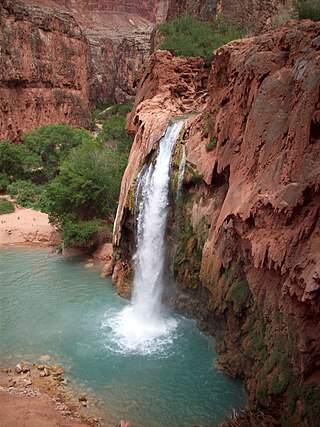
Havasu Falls is a waterfall of Havasu Creek, located in the Grand Canyon, Arizona, United States. It is within Havasupai tribal lands.

Bixby Bridge, also known as Bixby Creek Bridge, on the Big Sur coast of California, is one of the most photographed bridges in California due to its aesthetic design, "graceful architecture and magnificent setting". It is a reinforced concrete open-spandrel arch bridge. The bridge is 120 miles (190 km) south of San Francisco and 13 miles (21 km) south of Carmel in Monterey County on State Route 1.

Glass floors are made with transparent glass when it is useful to view something from above or below; whereas translucent glass is used when there is no need to view through. In either case, toughened glass is usually chosen, for its durability and resistance to breakage.

The Havasupai Indian Reservation is a Native American reservation for the Havasupai people, surrounded entirely by the Grand Canyon National Park, in Coconino County in Arizona, United States. It is considered one of America's most remote Indian reservations. The reservation is governed by a seven-member tribal council, led by a chairman who is elected from among the members of the council. The capital of the reservation is Supai, situated at the bottom of Cataract Canyon, one of the tributary canyons of the Grand Canyon. Havasupai is a combination of the words Havasu and pai, thus meaning "people of the blue-green waters".

Grand Canyon West Airport is a public airport 60 miles northwest of Peach Springs, in Mohave County, Arizona, United States. It is owned and operated by the Hualapai tribe and is on the Hualapai Indian Reservation.

Adventuredome is a 5-acre (2.0 ha) indoor amusement park at Circus Circus in Winchester, Nevada on the Las Vegas Strip. It is owned by Phil Ruffin. It is contained within a large glass dome, and offers various rides and attractions including the Canyon Blaster and El Loco roller coasters, a rock climbing wall, an 18-hole miniature golf course, a video game arcade, and carnival-type games. Because the park is enclosed, it is unaffected by weather, unlike most theme parks, and is open year-round. Every October from 2003 until 2017, the Adventuredome was turned into the Halloween-themed Fright Dome.
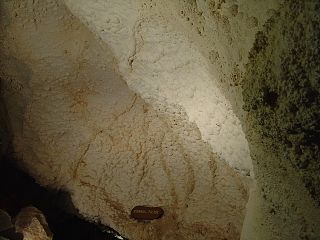
The Grand Canyon Caverns, located just a few miles east of Peach Springs, Arizona, lie 210 feet (64 m) below ground level. They are among the largest dry caverns in the United States. Dry caverns comprise only 3% of caverns in the world. Because of the lack of water, stalagmites and stalactites are rare in the caverns.

Arizona is a landlocked state situated in the southwestern region of the United States of America. It has a vast and diverse geography famous for its deep canyons, high- and low-elevation deserts, numerous natural rock formations, and volcanic mountain ranges. Arizona shares land borders with Utah to the north, the Mexican state of Sonora to the south, New Mexico to the east, and Nevada to the northwest, as well as water borders with California and the Mexican state of Baja California to the southwest along the Colorado River. Arizona is also one of the Four Corners states and is diagonally adjacent to Colorado.

Grand Canyon West is a census-designated place (CDP) in Mohave County, Arizona, United States, located on the Hualapai Reservation. The population was reported as 0 at the 2020 census. Grand Canyon West is home to the tribe's Grand Canyon business operations, including the Grand Canyon West Airport and the Grand Canyon Skywalk. Typically, they are open from 8:00 a.m. – 6:00 p.m., including all holidays.
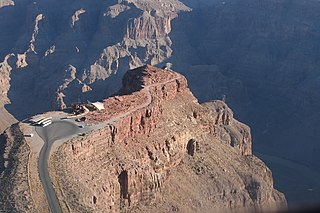
The Bat Cave mine was a bat guano mine in a natural cave located in the western Grand Canyon of Arizona at river mile 266, 800 feet (240 m) above Lake Mead.
Diamond Creek is an intermittent stream that flows through the Hualapai tribal reservation generally north from Peach Springs, Arizona to the Colorado River.

Skywire Live with Nik Wallenda is a Discovery Channel special that aired on June 23, 2013. The special was billed as a highwire walk across "the majestic Grand Canyon". Interpretations varied as to whether the actual location – the Little Colorado River Gorge in Navajo territory outside Grand Canyon National Park's borders – was truly part of the Grand Canyon.

Antares is an unincorporated community and census designated place (CDP) in Mohave County, Arizona, United States. As of the 2020 census, it had a population of 132. It exists along part of historic U.S. Route 66.
